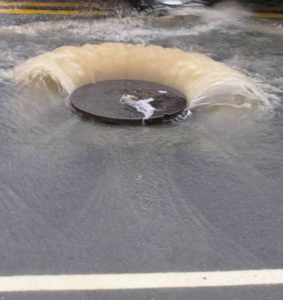The first big climate cost most of us will feel
 Recently, city officials in Springfield, Ohio forecast water and sewer rates to increase 40% in three years. That means a typical home using 3,000 gallons of water and currently paying $32 per month will see their bill rise to $46 by 2020.
Recently, city officials in Springfield, Ohio forecast water and sewer rates to increase 40% in three years. That means a typical home using 3,000 gallons of water and currently paying $32 per month will see their bill rise to $46 by 2020.
The jump in costs comes because the Environmental Protection Agency is requiring an expensive drainage project. it will prevent raw sewage from overflowing into local waterways causing a health hazard. Mayor Warren Copeland is not very pleased with the mandate, characterizing it as federal overreach. And no one likes the 50% increase in water rates it is causing. Since 2012, mandated projects have cost the city $80 million, which the Mayor feels was forced on the city. “The feds are the ones who decided we had to spend it. It wasn’t our decision. We didn’t have a choice,” he told The Springfield New-Sun.
Who decides whether we protect ourselves?
Having a climate-proof stormwater system is not optional. The EPA is required by the Clean Water Act to clamp down on systems that that can’t handle the higher precipitation events that come with global warming. There’s no local referendum, and dozens of US communities have started paying big money to upgrade their stormwater systems to EPA standards. More mandates are expected as climate change heightens storm intensities and runoff.
My hometown of Newport, RI already adds a fixed fee of $192 to most residents’ sewer bills. This pays for the $25 million in stormwater repairs the EPA mandated a while back. With this fee, plus heavy ongoing sewer repair costs, the average Newport households pays over $1,000 a year for town sewers. When you consider the median household income in the city is just over $61,000, that’s fee looms large.
And $80 million, $25 million – they are nothing. EPA’s estimate of what it will take for Boston to come into compliance is $898 million. For Pittsburgh, it’s $1.4 billion, and for DC over $2.5 billion. The EPA’s rationale for these expenditures is, of course, to prevent raw sewage from being washed into streets or waterways, reducing the health hazards of this pollution. But there are other benefits too, such as fewer rain-flooded basements, a better-smelling town, and fewer beach and shellfish closures. Stormwater overflows don’t just spread debris, oil, fertilizer, dog poop, and other pollutants from lawns, parking lots, and streets. Many towns have ‘combined sewer overflows,’ where stormwater drains can flood wastewater plants that handle toilet sewage, causing them to overflow.
Is it good to have no choice?
Even bigger infrastructure projects to protect us from the effects of climate change are ahead. River dikes against increased flooding, new airports as our current ones are drowned by sea level rise, new reservoirs and wells to combat drought, new highway surfacing to withstand higher temperatures, and so on – they’re all in our future. But those projects have a big difference. They won’t be mandated; they’ll be up to politicians and voters.
Which means they may not get funded – may be delayed or not get built at all. It’s a predicament for taxpayers. The investments are costly but, if put off until the next great flood, drought or storm, the damage could be even more costly – often four times as expensive! Given taxpayer’s reluctance to invest in improvements, perhaps we should be happy that a climate-proof stormwater system to protect against pollution is forced upon us. But I digress.
Some lower-cost ways to keep stormwater costs down
Stopping runoff before it goes into the sewer system is much cheaper than rebuilding drains and pipes. The phrase “green infrastructure” is being used more commonly these days to describe climate-proof stormwater solutions. Municipalities are building water gardens, rows of grass swales, permeable parking lots, and other surfaces that absorb rainwater and snowmelt before it reaches gutters and culverts. Many cities, such as Waynesboro, VA are implementing ponds to filter excess runoff before it hits the sewer system. in addition to holding the water, these ponds naturally filter it to remove pollutants like phosphorous and nitrogen, keeping those pollutants from leaching into local water supplies.
Homeowners can help. Water flows rapidly off our roofs, our driveways, even our lawns. By piling up some berms and swales, regrading edges of the lawn, maybe digging a little rain garden, adding rain barrels to our downspouts, exchanging our asphalt driveways for permeable pavers or gravel in a plastic grid system, and other techniques, we can turn our property into a sponge, keeping hundreds of gallons of water from flowing straight into the town system. Climate-proof stormwater techniques can keep our basements dry too.
Small farmers can do the same. Don Cameron, a farmer for 36 years, recently partially submerged his farm’s fields to help control runoff as well as recharge the underground aquifer. After years of extreme drought, the rains of 2016 wreaked havoc on California’s water reservoirs, and water retention solutions are a necessity to prevent flooding downstream.
Will similar costs hit your family budget soon? Eighty percent of the US population depend on these regulated storm sewer systems. You can check to see if your city is already under a mandate. And of course thousands of towns are facing stormwater cost increases even without an EPA mandate. Ask your City Hall what they’re doing to keep your future costs down.

